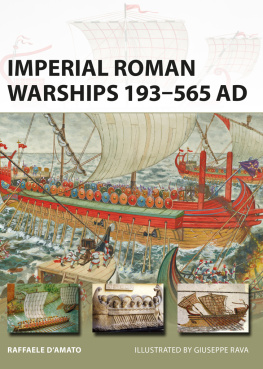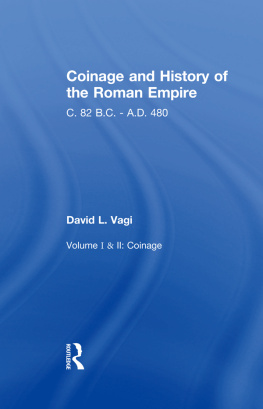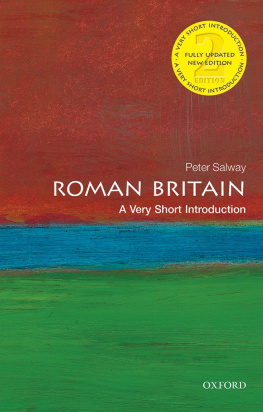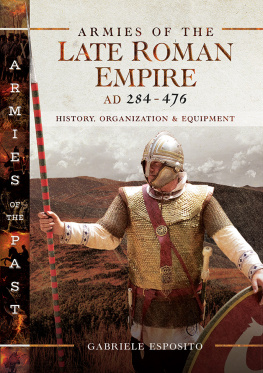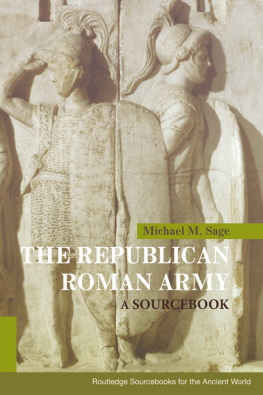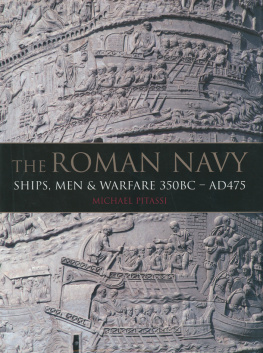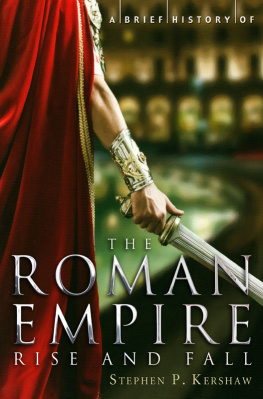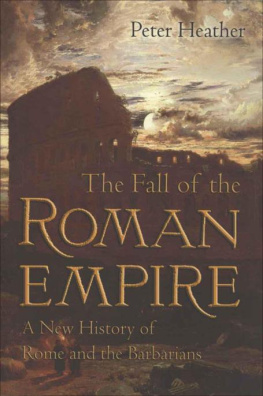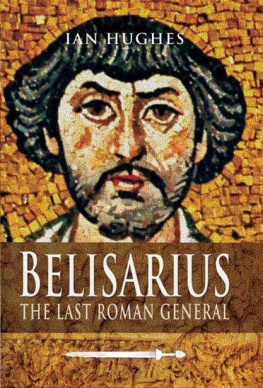Chronology
210 AD The Classis Britannica supports the land operations of the Emperor Septimius Severus in Caledonia
While sailing along the north Aegean coast, the Emperor Caracallas ship is wrecked; a galea of the Imperial Misenensis Fleet rescues him, and the whole Fleet receives the title of Pia Vindex
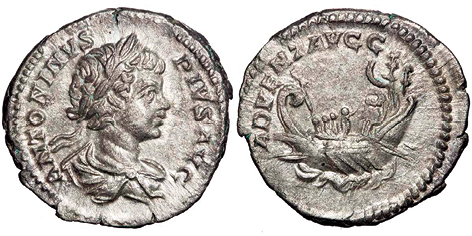
Denarius of the Emperor Caracalla. On the obverse you can read ANTONINVS PIVS AVG (Antoninus Pius Augustus) and on the reverse, on the ship, ADVENT AVGG ( Adventus Augustorum = arrival of the emperors). The galley presents a legionary vexillum on the prow, and a standard on the stern, with three passengers seated in cabin at the stern, probably Caracalla, Geta and their father Septimius Severus. The legionary flag at the prow and the legionary standards at the stern point towards the representation of a ship involved in some military expedition. The coin celebrates the delayed arrival in Rome of Septimius Severus in the year 202 AD with his two sons Caracalla and Geta. You can clearly see this galleys double-beaked ram, another sign of its military employment. (Mint of Rome, 202 AD, private collection, photo courtesy of Forum Ancient Coins)
238251 First Gothic war; sea and land raids by the Goths and pirate activities in the Black Sea; the Legio II Adiutrix receives from the Emperor Claudius II the appellative of Constans
The Emperor Pupienus chooses Ravenna as operative base against Maximinus
The Emperor Gordian III concentrates strong naval forces in the East and defeats the Sassanians
The Misenensis Fleet suppresses an African revolt against Gallienus
Continuous naval raids by the Saxons on the west coasts of Britain
In the Persian war the usurper Balista collects ships of Cilician ports and defeats the Persians near Pompeiopolis, taking the harem of the Sassanian King Shapur I (Zon., XII, 630; Syncellus, 7, 7427,743)
262266 Moesia and Thracia under threat by the Goths; the Germanic Herulians fleet of 500 ships is destroyed by Romano-Byzantine fleet before Byzantium. The Barbarians ravage Greece, sacking Athens, Corinth, Argos and Sparta; but the Athenian leader Publius Erennius Dexippus, with 2,000 men and the help of the Roman fleet, ambushes the Barbarians on their return journey; their army and fleet are finally destroyed by the Emperor Gallienus in Thracia
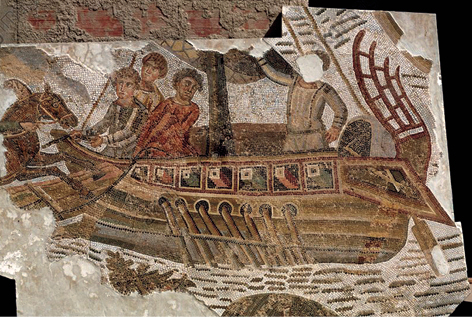
Roman Hippagus , from a third-century mosaic. (Medein, Tunisia, photo courtesy of the museum)
In Gaul, during the Gallic Empire of Postumus, a flotilla is established to guard the Upper Rhenus-Danubius Limes
The Roman navarcha Probus defeats Palmyrene army before Alexandria
Second Gothic invasion by sea; Herulians, Borani, Goths and other Germanic peoples attack the Bosphorean towns under Roman control. A fleet of 2,000 ships and 320,000 men from the Danube enter Roman territory. Marcus Aurelius Claudius defeats the invaders by sea and by land. The Roman fleet is reconstructed
The Borani Goths, after having armed the Bosphorean ships and recruited conscripts from the captive sailors, ravage the Pontic coasts as far as Trapezunte; Trapezunte falls and many Roman warships are captured
The Isaurian Lidius (Palfuerius) undertakes piracy along the coasts of Asia, Pamphilia and Lycia; besieged in the city of Cremna of Pisidia by the Roman legions, Lidius does not hesitate to sacrifice men, children and women, until he is killed by a traitor who allows the Romans to enter the city
The Frankish captives settled by the Emperor Claudius II in Pontus seize a number of ships and raid Greece and Eastern Sicily, to be destroyed by the Roman fleet near Carthage
293297 Constantius Chlorus restores Imperial authority in Britain in the wars against Carausius and his successor Allectus
The Constantinian Fleet, under the command of Crispus, son of Constantine, destroys the fleet of Licinius in the waters of Byzantium, capturing the city and sinking 130 enemy ships
Naval and land campaign of Julianus against the Sassanians
Gothic attempt to cross the Hellespontus (Dardanelles) is thwarted by a Roman fleet of the Eastern Empire
The Imperial fleet of Arcadius destroys the fleet of the Gothic Magister Militum Gainas on the Marmara Sea
Start of the fifth century Pirate activity of the Mangones, slave merchants from Galatia, along the coasts of Roman Africa
419 and 438 The Emperor Theodosius II forbids the divulging of the secrets of naval carpentry, probably to avoid its spread to the rising Vandal power in North Africa
Sea and land forces sent by Theodosius II to the West
445450 2,000 conscripts shipped on warships to Alexandria from Constantinople to put down ecclesiastical disorders
The Western Emperor Majorian defeats a Vandal fleet under the command of a relative of King Genseric, near Sinuessa in Campania
The combined fleet of Eastern and Western Roman Empires is destroyed by the Vandals of Genseric in the waters off Carthage
The fleet of Justinian the Great transports the troops of Belisarius to Africa for the war against the Vandals
An Ostrogothic fleet built in Italy and led by Totila successfully supports the invasion and recapture of Corsica and Sardinia against Roman naval power, but the Imperial ships destroy the Ostrogothic ships at Sena Gallica
To My Beloved Son, Flavius Victor
Acknowledgements
A great number of people, museums, and institutions have contributed again to this, my third volume on Roman warships. Very special thanks must be given to Admiral Domenico Carro, who once more shared with me his precious knowledge of the Roman navy, and enriched the book with his wonderful illustrations. Professor Livio Zerbini of Ferrara University has as always given his invaluable help in obtaining, from different museums and institutions, permission to see and photograph the related material in their collections. The material from the Bardo and Tunisia museums I owe to the kindness of my dear colleague and friend, the conservator of the Museum of Carthage, Hamden Ben Rhomdane. The magnificent photograph of the Naval Battle from the Museum of Algeri is thanks to the skill and courtesy of my dear friend Oulmi Med Lakhdar, professor of the University of Algiers.
To the Ancient Forum Coins I owe the splendid coins which are reproduced in the book. Particular thanks must be given to the Museum fur Antike Schiffahrt des RGZM, Mainz, for the magnificent photos and permission to reproduce them in this book.
For the photographic credits I would like to thank the following museums and institutions: the Archaeological Museum of Ephes; the National Museum of Pozarevac; the British Museum; the Museum of Constantina-Cirta; the Museums of the Villa del Casale at Piazza Armerina; the Low Ham Villa Museum; the Biblioteca Apostolica Vaticana; the Zeugma Mosaic Museum; the Bodleian Library; the Naval Museum of Madrid; and the Biblioteca Ambrosiana of Milano. Special thanks must be given also to Dr Andrea Salimbeti and Dr Massimo Bizzarri for their always precious assistance and inestimable help in collecting the photographic material, in researching the sources, in preparing the drawings, in patiently assisting in my various travels and in many other numerous ways. Last but not least, I am deeply grateful to my dear friend and illustrator Giuseppe Rava for providing a splendid new set of illustrations on the previously obscure subject of the late Imperial Roman navy.

